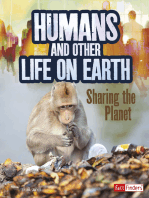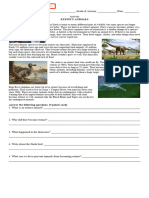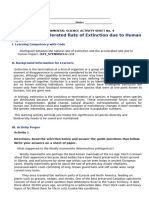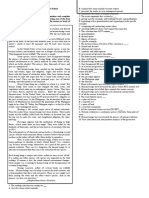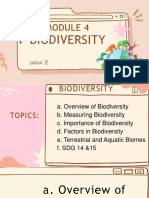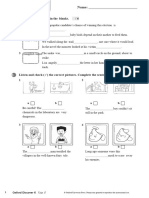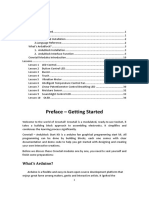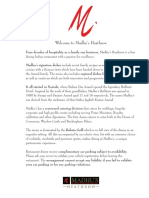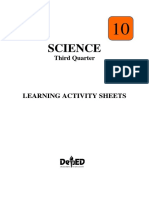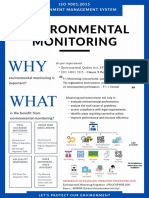0 ratings0% found this document useful (0 votes)
5 viewsJAo N43 OYBOCh 7 RH I
JAo N43 OYBOCh 7 RH I
Uploaded by
Aliaa SufianThe document discusses extinct and endangered animals. It explains that extinction occurs naturally from environmental changes or habitat loss, or through human interaction like overhunting and pollution. Examples given of extinct species are dinosaurs and woolly mammoths, while endangered species discussed include black rhinos, orangutans, blue whales, Bengal tigers, and giant pandas.
Copyright:
© All Rights Reserved
Available Formats
Download as PDF, TXT or read online from Scribd
JAo N43 OYBOCh 7 RH I
JAo N43 OYBOCh 7 RH I
Uploaded by
Aliaa Sufian0 ratings0% found this document useful (0 votes)
5 views3 pagesThe document discusses extinct and endangered animals. It explains that extinction occurs naturally from environmental changes or habitat loss, or through human interaction like overhunting and pollution. Examples given of extinct species are dinosaurs and woolly mammoths, while endangered species discussed include black rhinos, orangutans, blue whales, Bengal tigers, and giant pandas.
Original Title
JAoN43OYBOCh7RhI
Copyright
© © All Rights Reserved
Available Formats
PDF, TXT or read online from Scribd
Share this document
Did you find this document useful?
Is this content inappropriate?
The document discusses extinct and endangered animals. It explains that extinction occurs naturally from environmental changes or habitat loss, or through human interaction like overhunting and pollution. Examples given of extinct species are dinosaurs and woolly mammoths, while endangered species discussed include black rhinos, orangutans, blue whales, Bengal tigers, and giant pandas.
Copyright:
© All Rights Reserved
Available Formats
Download as PDF, TXT or read online from Scribd
Download as pdf or txt
0 ratings0% found this document useful (0 votes)
5 views3 pagesJAo N43 OYBOCh 7 RH I
JAo N43 OYBOCh 7 RH I
Uploaded by
Aliaa SufianThe document discusses extinct and endangered animals. It explains that extinction occurs naturally from environmental changes or habitat loss, or through human interaction like overhunting and pollution. Examples given of extinct species are dinosaurs and woolly mammoths, while endangered species discussed include black rhinos, orangutans, blue whales, Bengal tigers, and giant pandas.
Copyright:
© All Rights Reserved
Available Formats
Download as PDF, TXT or read online from Scribd
Download as pdf or txt
You are on page 1of 3
Cambridge International School
English worksheet stage 5
Name: ______________________ Grade: __________
Reading Comprehension
Extinct and Endangered Animals
There are no more dinosaurs living on the Earth.
They are extinct, which means there is no
longer a certain kind of plant or animal living
anywhere in the world. A species is a certain
group of living organisms, like dinosaurs,
humans, birds, and many others. Scientists
believe many organisms, along with the
dinosaurs, died out when a large asteroid
collided with the Earth. The collision caused a mass extinction, which occurs at
a faster rate over a very short time-period.
There are usually two reasons for the extinction of animals and other living
things. The first is naturally, which may take place when animals do not adapt
to natural changes in their environment. For example, if the habitat of a bird
suddenly changes, and if the bird does not adapt, it could become extinct.
Examples of naturally occurring extinction may take place during a change in
the climate. This took place during the Ice Age when the temperature of the
Earth was much lower. During a natural extinction, the species may be
eliminated by new predators that move into their environment. The food
needed to survive may no longer be available.
Another example of this type of extinction was the wooly mammoth, a relative
of the elephant, which died out 10,000 years ago due to climate change and
the disappearance of its habitat.
The second reason for the extinction of animals is human interaction, which
includes hunting and habitat destruction caused by people. An animal's
environment may be destroyed by pollution or construction, such as the
destruction of parts of a rainforest. Humans also overhunt sometimes wiping out
an entire species. In addition, the moving of non-native species into an area
where they are not usually found may lead to the extinction of another species.
Examples include the Dodo bird that became extinct due to overhunting and
other animals moving into its environment. The passenger pigeon died out due
to the destruction of its habitat, as well as overhunting. There are many animals
that have become extinct, but when animals are in danger of becoming
extinct, yet still survive, they are called endangered animals.
Endangered means a plant or animal is at risk of becoming extinct. This occurs
when the population of a certain animal is so low, that they are in danger of
dying out forever and becoming extinct. The reasons for an animal to become
endangered are mostly the same as for those that have become extinct. There
are many animals in the world today that are on the endangered species list.
Some are so in danger of becoming extinct, they can only be found in a zoo.
Some of the endangered animals in the world as of 2017 include the black
rhino, found in Africa, where hunting has led to the decline of its population
with fewer than 5,000 of them still surviving. The orangutan found in the country
of Malaysia is a highly intelligent relative of the ape family, but it too has been
endangered due to the loss of their habitat and overhunting. The blue whale is
endangered and threatened by climate change, habitat loss, and poisonous
substances in the water. Finally, two other endangered species examples
include the Bengal tiger, giant panda, mountain gorilla, sea lions, and others.
Answer the questions.
1) All the following are endangered animals EXCEPT:
A: Sea lions
B: Wooly mammoths
C: Bengal tigers
D: Giant pandas
2) All the following are extinct species EXCEPT:
A: Dinosaurs
B: Orangutans
C: Carrier pigeons
D: Dodo birds
3) Which of the following is a reason for the extinct and endangered animals?
A: Climate change
B: Habitat destruction
C: Overhunting
D: All the above
4) New predators moving into the environment may first lead to which of the
following?
A: Extinction of another species
B: An increase in new food sources
C: Endangered species
D: Loss of land resources
5) Which of the following best defines a mass
extinction?
A: An extinction that occurs at a faster rate compared to a typical extinction
B: An extinction of just one animal or plant species
C: An extinction in just one area of the world
D: All the above
6) Hunting and habitat destruction are reasons for which of the following types
of extinction?
A: Natural
B: Human interaction
C: Mass
D: None of the above.
Submit
You might also like
- English - Stage 5 - 01 - MS - 7RP - AFP - tcm142-594888Document11 pagesEnglish - Stage 5 - 01 - MS - 7RP - AFP - tcm142-594888Aliaa SufianNo ratings yet
- 6 WhyDoHumansValueMusic by Bennett ReimerDocument16 pages6 WhyDoHumansValueMusic by Bennett ReimerDimitraVin100% (1)
- Hunter TC3500Document31 pagesHunter TC3500dionisio emilio reyes jimenezNo ratings yet
- Module 2 - Resultant of Force SystemDocument17 pagesModule 2 - Resultant of Force SystemErika Siosan100% (1)
- Case IH Self Propelled 1460 ReferenceDocument2 pagesCase IH Self Propelled 1460 ReferenceBalázs NémethNo ratings yet
- Extinct and Endangered AnimalsDocument2 pagesExtinct and Endangered AnimalsMaria Jose Aguilera ZuluagaNo ratings yet
- Biodiversity HotspotDocument2 pagesBiodiversity Hotspotr_marangga1432203No ratings yet
- Factors of ExtinctionDocument5 pagesFactors of Extinctionpreetstosh7No ratings yet
- Types of Biodiversity 2Document10 pagesTypes of Biodiversity 2Mecaella CañizaresNo ratings yet
- Hand_outs_AiShie (1)Document2 pagesHand_outs_AiShie (1)hariesanraqNo ratings yet
- WEEK3 - Environmental ScienceDocument2 pagesWEEK3 - Environmental ScienceAlynnaNo ratings yet
- NotesDocument6 pagesNotesmariavarkis731No ratings yet
- Extinct SpeciesDocument25 pagesExtinct SpeciesMisael Nuñez100% (1)
- Evidence 3 Life ScienceDocument3 pagesEvidence 3 Life SciencejoshgamerproNo ratings yet
- Science and EnglishDocument11 pagesScience and EnglishGillian Grace ReyesNo ratings yet
- 1-1.4 The Sixth Extinction PDFDocument3 pages1-1.4 The Sixth Extinction PDFNatthanicha WeerachawengkulNo ratings yet
- Environmental Issues: Name - Roll NO.Document22 pagesEnvironmental Issues: Name - Roll NO.gorubNo ratings yet
- G9-Threats To Biodiversity 11.2Document16 pagesG9-Threats To Biodiversity 11.2DeclanNo ratings yet
- Extinct Animals - ActivityDocument1 pageExtinct Animals - ActivityBonachita YamNo ratings yet
- Nlenvirte 2072Document5 pagesNlenvirte 2072api-244168124No ratings yet
- Argumentative Text EssayDocument7 pagesArgumentative Text Essayapi-551148489No ratings yet
- Animals at RiskDocument2 pagesAnimals at RiskAnnalisa TealdiNo ratings yet
- Species and 70 Percent of The Terrestrial Vertebrate Species Alive at The TimeDocument9 pagesSpecies and 70 Percent of The Terrestrial Vertebrate Species Alive at The TimeSnarkyArchieNo ratings yet
- Saving Animals E-Award PresentationDocument74 pagesSaving Animals E-Award PresentationNaphton ProjectsNo ratings yet
- Extinction!: Going HungryDocument1 pageExtinction!: Going HungryeibsourceNo ratings yet
- Unit Three Lesson TwoDocument3 pagesUnit Three Lesson Twohabibsherif2020No ratings yet
- Endagered AnimalsDocument1 pageEndagered AnimalsSuvali ShettyNo ratings yet
- Extinct AnimalsDocument6 pagesExtinct AnimalsSilvia del Rosario ChumbitaNo ratings yet
- Exam 1 Review-Mass Extinction A Dying WorldDocument3 pagesExam 1 Review-Mass Extinction A Dying WorldBianeth SantafeNo ratings yet
- MockTest3Document5 pagesMockTest3lorenafernandezroldanNo ratings yet
- Text Book Exercise Chapter 7Document5 pagesText Book Exercise Chapter 7adithyaanurag2010No ratings yet
- Ncert Solutions Class 8 Science Chapter 7Document9 pagesNcert Solutions Class 8 Science Chapter 7JollyNo ratings yet
- Science Unit 1 Standard 6Document12 pagesScience Unit 1 Standard 6Abe Kob0% (1)
- The Extinction Crisis: Age of The Earth Life On EarthDocument4 pagesThe Extinction Crisis: Age of The Earth Life On EarthUPSMamaNo ratings yet
- Summary Practice Official 2017 SampleDocument1 pageSummary Practice Official 2017 Sampletuantu_51No ratings yet
- Science9 q1 CLAS5 ExtinctionDocument16 pagesScience9 q1 CLAS5 ExtinctionDennis PucotNo ratings yet
- UG SEM 6 C14T Unit-7Document7 pagesUG SEM 6 C14T Unit-7Messi10 BtyNo ratings yet
- Class 8 Science Chapter 6 Conservation of Plants and AnimalsDocument6 pagesClass 8 Science Chapter 6 Conservation of Plants and AnimalsSudipto DuttaNo ratings yet
- Science Note.Document3 pagesScience Note.sethjayasunderaNo ratings yet
- What Are Endangered Species?Document9 pagesWhat Are Endangered Species?malvikaNo ratings yet
- Lesson 7 Species ExtinctionDocument38 pagesLesson 7 Species ExtinctionpreianhajaneNo ratings yet
- Notes Lesson 4 Natural Extinction RateDocument3 pagesNotes Lesson 4 Natural Extinction Ratebrentgenona76No ratings yet
- Sample For AnalysisDocument1 pageSample For AnalysisM, Mercado, Jerard C.No ratings yet
- The Extinction of Animals, JANETHDocument4 pagesThe Extinction of Animals, JANETHJaneth VelázquezNo ratings yet
- Rishabh VK - Biology Project - Biodiverity - 8ADocument7 pagesRishabh VK - Biology Project - Biodiverity - 8ARishabh Vasudev KapatkarNo ratings yet
- ExntitionDocument2 pagesExntitionlohithrkarkera80No ratings yet
- Thuyết trình ielts chủ đề 3 10E5Document4 pagesThuyết trình ielts chủ đề 3 10E5lephuongbach2017No ratings yet
- ReadingDocument5 pagesReading25-Trần Mỹ Phương Lớp 8.13No ratings yet
- Class 8TH Bio CH7Document7 pagesClass 8TH Bio CH7Chirag KashyapNo ratings yet
- "Extinct" Amphibians Rediscovered After Nearly Half A CenturyDocument3 pages"Extinct" Amphibians Rediscovered After Nearly Half A CenturyCHRISTIAN SORIANONo ratings yet
- Endangered AnimalsDocument7 pagesEndangered AnimalsCatalin IacobNo ratings yet
- Appreciating The Beauty of NatureDocument20 pagesAppreciating The Beauty of NatureLeslie LocsinNo ratings yet
- Unit 3 How The Dinosaurs DisappearedDocument1 pageUnit 3 How The Dinosaurs DisappearedIuaena UlNo ratings yet
- Endangered Animals: Autors Fabián Yesid Ramírez Cleidy Yulieth BastillaDocument3 pagesEndangered Animals: Autors Fabián Yesid Ramírez Cleidy Yulieth BastillacleidyNo ratings yet
- Geography Project-1 (Akshara)Document6 pagesGeography Project-1 (Akshara)preethamkalle07No ratings yet
- THE Extinction: Plants and AnimalsDocument15 pagesTHE Extinction: Plants and AnimalsKaren Baltazar BelarminoNo ratings yet
- Envsci BiodiversityDocument88 pagesEnvsci BiodiversityAnn Jielyn Ablao ManongNo ratings yet
- AH, 08 de Extinction Print SourcesDocument5 pagesAH, 08 de Extinction Print SourcesjesjentonNo ratings yet
- Provas de Proficiencia Ingles 1Document10 pagesProvas de Proficiencia Ingles 1Daniel AguiarNo ratings yet
- Mock Test 3Document5 pagesMock Test 3lorenafernandezroldanNo ratings yet
- Article - Pro - Con - Should We Bring Back Extinct AnimalsDocument4 pagesArticle - Pro - Con - Should We Bring Back Extinct Animalscampbell.destiney29No ratings yet
- Introduction of Exotic AnimalsDocument5 pagesIntroduction of Exotic Animalsmadipalmer_No ratings yet
- Endangrd PDFDocument5 pagesEndangrd PDFdavidcosmin186832No ratings yet
- Od6 Ut06Document2 pagesOd6 Ut06Aliaa SufianNo ratings yet
- Od6 Ut18Document2 pagesOd6 Ut18Aliaa SufianNo ratings yet
- Stage 5 Science Term 1 Final Review PackDocument28 pagesStage 5 Science Term 1 Final Review PackAliaa SufianNo ratings yet
- Od6 Ut17Document2 pagesOd6 Ut17Aliaa SufianNo ratings yet
- Key Answer Stage 5 Math Term 1 Final Review PackDocument42 pagesKey Answer Stage 5 Math Term 1 Final Review PackAliaa SufianNo ratings yet
- Stage 5 Math Worksheet Tuesday 17th Nov 2020Document3 pagesStage 5 Math Worksheet Tuesday 17th Nov 2020Aliaa SufianNo ratings yet
- Stage 6 Science Term 2 Final Review PackDocument29 pagesStage 6 Science Term 2 Final Review PackAliaa SufianNo ratings yet
- Stage 4 Math Review Pack Term 1 Final-2021-2022Document13 pagesStage 4 Math Review Pack Term 1 Final-2021-2022Aliaa SufianNo ratings yet
- Stage 6 Math Worksheet Thursday 11th Feb 2021Document3 pagesStage 6 Math Worksheet Thursday 11th Feb 2021Aliaa SufianNo ratings yet
- Stage 6 Science t2 Final Answer KeyDocument26 pagesStage 6 Science t2 Final Answer KeyAliaa Sufian100% (1)
- General Specifications: Axfa11G Magnetic Flowmeter Remote ConverterDocument10 pagesGeneral Specifications: Axfa11G Magnetic Flowmeter Remote ConverterEmerson Müller Juarez AvilaNo ratings yet
- Biography of Bana BhanteDocument12 pagesBiography of Bana Bhantebhante3525100% (1)
- Case Study ThrombocytopeniaDocument8 pagesCase Study ThrombocytopeniaAmina TariqNo ratings yet
- Alarm Device ListDocument5 pagesAlarm Device Listluiz carlos bonafini jrNo ratings yet
- Big Bear and Little Bear Myth Timeline WorksheetDocument4 pagesBig Bear and Little Bear Myth Timeline WorksheetfussyhuskyNo ratings yet
- Eng Gen 151 HW 03Document2 pagesEng Gen 151 HW 03Sasan ANo ratings yet
- Basket Centrifugesand REFLUXClassiferspjohau 120413 EMAILDocument7 pagesBasket Centrifugesand REFLUXClassiferspjohau 120413 EMAILJoshua RobinsonNo ratings yet
- Ten Minutes To Tremendous PowerDocument38 pagesTen Minutes To Tremendous PowerLance FoxNo ratings yet
- E-Light E-Light E-Light E-Light System System System SystemDocument12 pagesE-Light E-Light E-Light E-Light System System System SystemDaniel FalconNo ratings yet
- Sharath Resume 2021Document2 pagesSharath Resume 2021MD ABDUL MUHAIMINNo ratings yet
- Basic Splinting Techniques PDFDocument5 pagesBasic Splinting Techniques PDFLeny MeiriyanaNo ratings yet
- An VCHNDocument14 pagesAn VCHNEko KiswoyoNo ratings yet
- Bajaj Allianz General Insurance Company LTDDocument5 pagesBajaj Allianz General Insurance Company LTDCreative VaibhavNo ratings yet
- 50 CR Mo 4Document4 pages50 CR Mo 4Diogo Nascimento100% (1)
- ArduBlock For Crowtail Start KitDocument37 pagesArduBlock For Crowtail Start Kit張文源老師Cheung Man YuenNo ratings yet
- Welcome To Madhu's HeathrowDocument9 pagesWelcome To Madhu's HeathrowsriramNo ratings yet
- Chapter 1 The Nature of Sociological PerspectivesDocument5 pagesChapter 1 The Nature of Sociological PerspectivesDiana ArceoNo ratings yet
- Surfactant FloodingDocument13 pagesSurfactant FloodingVlassis SarantinosNo ratings yet
- Everson WWTP Upgrades - CQA PlanDocument86 pagesEverson WWTP Upgrades - CQA PlanKousher Hasan ShimulNo ratings yet
- Meat ProcessingDocument6 pagesMeat ProcessingNorly FaderesNo ratings yet
- Science 10 LAS Quarter 3Document89 pagesScience 10 LAS Quarter 3Christopher John Natividad100% (4)
- EMS Awareness PosterDocument2 pagesEMS Awareness PosterShahfiee AbdullahNo ratings yet
- CD Nozzle Simulator Version 1.1 Copyright William DeveDocument6 pagesCD Nozzle Simulator Version 1.1 Copyright William DeveAdam RaynardNo ratings yet
- Cimstar 60 MSDSDocument6 pagesCimstar 60 MSDSJosé L LópezNo ratings yet
- BhelDocument108 pagesBhelVivek Kumar0% (1)
- World: Cassava - Market Report. Analysis and Forecast To 2020Document7 pagesWorld: Cassava - Market Report. Analysis and Forecast To 2020IndexBox Marketing0% (1)






